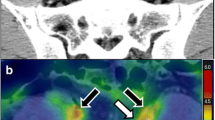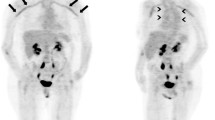Abstract
The most common manifestation of cardiovascular syphilis, a rare diagnosis since the introduction of penicillin, is aortitis of the ascending aorta. Since the majority of patients with uncomplicated aortitis are asymptomatic, early diagnosis is difficult. We report the case of an HIV–positive patient with asymptomatic syphilitic aortitis that was incidentally diagnosed with F–18–fluorodeoxyglucose (FDG) positron emission tomography (PET). We conclude that FDG–PET could become a promising new imaging technique for both diagnosis and follow–up of patients with syphilitic aortitis.
Similar content being viewed by others
Author information
Authors and Affiliations
Corresponding author
Additional information
This paper is dedicated to the founders of the Walter Marget Foundation, D. Adam and F. Daschner, in gratitude for their support of the training in infectious diseases.
Rights and permissions
About this article
Cite this article
Kösters, K., Bleeker–Rovers, C.P., van Crevel, R. et al. Aortitis Diagnosed by F–18–Fluorodeoxyglucose Positron Emission Tomography in a Patient with Syphilis and HIV Coinfection. Infection 33, 387–389 (2005). https://doi.org/10.1007/s15010-005-5064-6
Received:
Accepted:
Issue Date:
DOI: https://doi.org/10.1007/s15010-005-5064-6




